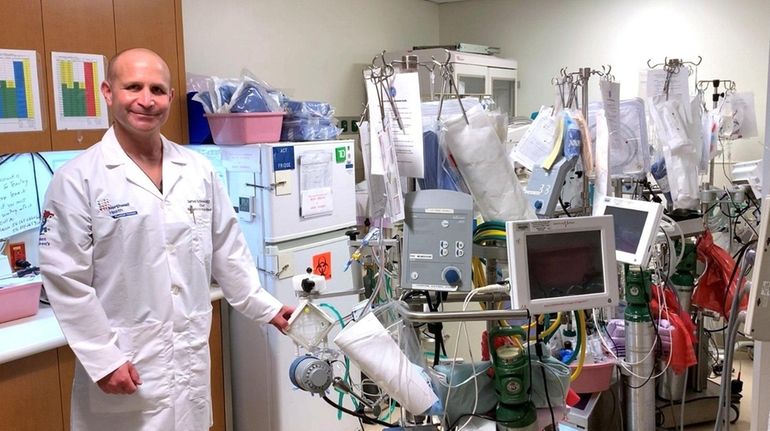
Doctors on alert for condition that develops in kids after contracting COVID

Dr. James Schneider, chief of pediatric critical care at Cohen Children's Medical Center, said 10 to 12 children were admitted to the hospital with MIS-C in January — including several within the last week — many requiring a stay in the intensive care unit. Credit: Northwell Health
Pediatricians around Long Island are on high alert for cases of multisystem inflammatory syndrome (MIS-C), a rare but serious condition that emerges in some children weeks after they were infected with COVID-19.
Doctors at Cohen Children’s Medical Center and Stony Brook Children’s Hospital said they have seen cases this month and expect to see more in the coming weeks.
Only 25¢ for 5 months
Pediatricians around Long Island are on high alert for cases of multisystem inflammatory syndrome (MIS-C), a rare but serious condition that emerges in some children weeks after they were infected with COVID-19.
Doctors at Cohen Children’s Medical Center and Stony Brook Children’s Hospital said they have seen cases this month and expect to see more in the coming weeks.
What to know
Doctors on Long Island are starting to see more cases of multisystem inflammatory syndrome (MIS-C), a serious condition that emerges in some children weeks after they were infected with COVID-19.
The symptoms of MIS-C include fever, rash, red eyes, swollen hands, breathing problems and abdominal pain.
The state Department of Health said it has investigated and confirmed 641 cases of MIS-C and three deaths attributed to MIS-C since the start of the pandemic.
The condition, first identified at the start of the pandemic in spring 2020, causes different body parts to become inflamed, including the heart, lungs, kidneys, brain, skin, eyes or gastrointestinal organs, according to the Centers for Disease Control and Prevention.
Dr. James Schneider, chief of pediatric critical care at Cohen Children’s Medical Center, said 10 to 12 children were admitted to the hospital with MIS-C in January — including several within the last week — many requiring a stay in the intensive care unit. Most of the young patients were not vaccinated against COVID-19.
"We generally see this syndrome occur about three to five weeks after an infection," Schneider said. "We know that the big surge of infections was right around the new year. We're only maybe a week or less into what may be the beginning of a surge. We'll have to see if it's too early to tell."
Studies have shown MIS-C is found more frequently in Hispanic and non-Hispanic Black children.
The New York State Department of Health said it has investigated and confirmed 641 cases of MIS-C and three deaths attributed to MIS-C since the start of the pandemic.
Dr. Sharon Nachman, chief of the Division of Pediatric Infectious Diseases at Stony Brook Children’s Hospital, said her hospital is "just starting to see cases."
"If you talk to colleagues around the country, we’re all talking about the same thing," Nachman said. "All the hospitals are starting to see them."
A rare but serious condition
Doctors weren’t sure what they were seeing in the spring of 2020 when seriously ill children were being admitted with a high fever, rash, swollen hands, breathing problems and abdominal pain. The symptoms were similar to Kawasaki disease, which also targets young children. Researchers determined it was developing in children who had COVID-19, even if their cases had been mild or asymptomatic.
"We saw a lot of children in a short amount of time," Schneider said. "It took a lot of time for them to be diagnosed because people weren’t aware of this yet. But now, the level of awareness among physicians is fairly high."
The CDC said there have been 6,431 MIS-C cases and 55 deaths from the illness across the United States since the start of the pandemic. While the median age of patients is about 9, it has been identified in infants as well as older teens. About half of the cases are kids between the ages of 5 and 13, the agency said.
Concerns about a new surge
When the first cases were discovered in the early days of the pandemic, schools were still doing online learning, people were in lockdown and practicing social distancing, Nachman pointed out, which prevented more children from becoming infected.
Many protections were still in place when the delta variant emerged and another wave of COVID-19 rolled across the country. But the highly infectious omicron variant came during the holiday season when people were gathering, and fewer were masking, Nachman pointed out, leading to more infections among adults and children.
Dr. Leonard Krilov, chairman of pediatrics and chief of Pediatric Infectious Disease at NYU Langone Hospital-Long Island said there is a chance omicron may not spark as many MIS-C cases. The hospital had one case a few weeks ago, but none at the present time.
"It is thought that MIS-C is related to exaggerated inflammatory responses to a prior COVID infection," Krilov said. "It is possible that since omicron causes a somewhat milder infection than seen with earlier variants, omicron may not lead to a surge in MIS-C cases … but it's too early to know."
Treating and preventing MIS-C
Schneider said it’s important for parents to keep an eye out for symptoms that include fever that lasts more than a day or two, rashes, red eyes, and gastrointestinal issues such as vomiting and diarrhea — and take them to a pediatrician immediately for evaluation.
Treatment for MIS-C in the hospital depends on the needs of each young patient, Nachman said, but in general could include immunoglobulin (antibodies), aspirin and steroids, as well as making sure they stay hydrated.
Even if a child already has had COVID-19, experts said they should still get vaccinated to ward off future infections and MIS-C.
"We don’t want them to get COVID," Nachman said. "We really, really don’t want them to get MIS-C."
